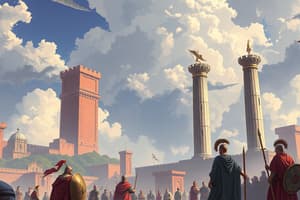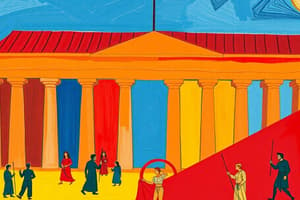Podcast
Questions and Answers
What characterized the Roman Republic's political system?
What characterized the Roman Republic's political system?
- A system in which the patricians held both legislative and executive power
- A system in which the plebeians held both legislative and executive power
- A system in which the people held both legislative and executive power (correct)
- A system in which the slaves held both legislative and executive power
Who were at the top of the social hierarchy in the Roman Republic?
Who were at the top of the social hierarchy in the Roman Republic?
- Plebeians
- Senators
- Patricians (correct)
- Slaves
What was the main role of the Senate in the Roman Republic?
What was the main role of the Senate in the Roman Republic?
- To protect the rights of slaves
- To hold executive power
- To make laws and declare war (correct)
- To represent the interests of the plebeians
What was the status of plebeians in the Roman Republic?
What was the status of plebeians in the Roman Republic?
What was the position of slaves in the Roman Republic?
What was the position of slaves in the Roman Republic?
Which group had the power to make laws and declare war in the Roman Republic?
Which group had the power to make laws and declare war in the Roman Republic?
Who were part of the ruling class in the Roman Republic?
Who were part of the ruling class in the Roman Republic?
What was the role of plebeians in the political institutions of the Roman Republic?
What was the role of plebeians in the political institutions of the Roman Republic?
What was the function of the consuls in the Roman Republic?
What was the function of the consuls in the Roman Republic?
How were the assemblies in the Roman Republic organized?
How were the assemblies in the Roman Republic organized?
What was the role of the Senate in the Roman Republic?
What was the role of the Senate in the Roman Republic?
Who had the power to elect officials and to pass laws in the Roman Republic?
Who had the power to elect officials and to pass laws in the Roman Republic?
What was the main purpose of the government structure in the Roman Republic?
What was the main purpose of the government structure in the Roman Republic?
What was a key feature of the government structure in the Roman Republic?
What was a key feature of the government structure in the Roman Republic?
What gave the courts in the Roman Republic power over both the consuls and the Senate?
What gave the courts in the Roman Republic power over both the consuls and the Senate?
How long did the Roman Republic endure?
How long did the Roman Republic endure?
Flashcards are hidden until you start studying
Study Notes
The Roman Republic
The Roman Republic was a period of Roman civilization lasting from 509 BC to 27 BC. It was characterized by a political system in which the people held both legislative and executive power. In this article, we will explore the social classes, political institutions, and government structure of the Roman Republic.
Social Classes
The Roman Republic was a highly stratified society, with a clear hierarchy of social classes. At the top were the patricians, or nobles, who were the ruling class. They were wealthy and held political power. Below them were the plebeians, or commoners, who made up the vast majority of the population. They were not allowed to hold political office, but they could vote on public issues.
The slaves, who were at the bottom of the social hierarchy, were not considered citizens and had no political rights. They were treated as property and were used for labor in various industries.
Political Institutions
The political institutions of the Roman Republic were designed to represent the interests of the different social classes. The Senate, which was made up of patricians, was the highest political body in the Republic. It had the power to make laws and to declare war.
The people's assemblies, which were made up of plebeians, were the other major political institutions in the Republic. They had the power to elect officials, to pass laws, and to hold trials. The assemblies were divided into different groups based on the different tribes into which the Roman population was divided.
Government Structure
The government structure of the Roman Republic was based on a system of checks and balances. The consuls, who were elected by the people's assemblies, were the chief executive officers of the Republic. They were responsible for enforcing the laws and for conducting foreign policy.
The Senate, which was the highest political body in the Republic, served as a check on the power of the consuls. It had the power to veto any actions taken by the consuls and to declare war.
The courts, which were made up of judges elected by the people's assemblies, served as a check on the power of both the consuls and the Senate. They had the power to interpret the laws and to enforce them.
The Roman Republic was a complex and sophisticated political system that was designed to represent the interests of the different social classes. It was characterized by a clear hierarchy of social classes, a system of political institutions, and a government structure based on a system of checks and balances. This system allowed the Roman Republic to endure for over 500 years and to achieve a great deal of political and cultural achievements
Studying That Suits You
Use AI to generate personalized quizzes and flashcards to suit your learning preferences.




